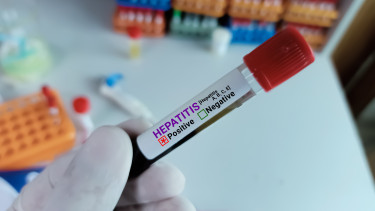Coronavirus reproduction number in Hungary at dangerous level, mathematician warns

A team of mathematicians at the University of Szeged use mobility and various other figures relevant in the epidemic and obtained from electronic health data bases to integrate and present them in a transparent and comprehensible system to policy makers, explained Röst.
The team consults with the relevant ministry on a weekly basis, prepares reports and specialised materials. During the spring wave in the pandemic, it provided policy makers with daily reports and also put together strategic analyses and recommendations on various special subjects.

Team of matematicians working on epidemiological models at the University of Szeged
When asked if the spring numbers in the pandemic proved the team's model right, Röst replied that in their very first document they found the number of contacts must be lowered by over 60% in order to quash the spread of coronavirus. Data in that period verified that indeed there was a reduction of over 60% on a national average and up to 90% in Budapest. This was key to keeping the virus at bay.
Röst emphasised that while preventing transmission via reducing contacts is an effective solution, it has high social costs and cannot be sustained in the long term; other tools need to replace a drastic reduction of contacts.
The team had stressed back in April that a combined strategy would be needed. While social distancing needs to be maintained to a certain degree, hygiene is crucial, and so is the use of face masks in select areas, and the efficiency of testing and contact tracing must also be improved urgently.
The team said in April that with an immediate detection of 15% of those infected and contact tracing had a 70% coverage, the peak of the epidemic curve could be halved.
As regards testing, he welcomed that medical universities started to actively test samples, but he stressed that
no major improvement has been achieved since then. Even the current capacity is not used to its full extent.
Röst stressed that when it comes to protection against the coronavirus it is not only the number of tests but also speed that matters a lot.
When asked why speed matters so much, he explained that testing serves three purposes.
- It has a clinical function, namely that if someone falls ill they get tested and the results show which ward they need to be referred to and what kind of treatment they need.
- Secondly, it has an observation function. It is important to know how many cases are in the country, in which regions and in which social groups.
- The third key function is when a person is diagnosed with COVID-19 he/she must be isolated to break the chain of transmission.
For now, Hungary uses only the first (clinical) function of testing. A model compiled by the team shows that if the strategy is to test only those that show severe symptoms, their isolation will have a negligible impact on the rate at which the epidemic is spreading.
"We are already aware that people with coronavirus are the most contagious one or two days before they show symptoms and few days after they begin to feel ill," said Röst.
If we focus exclusively on those with symptoms we'll lose a lot of time.
"When people start to feel ill, they may wait a couple of days before taking it seriously and calling their doctor. If the GP suspects coronavirus, he/she request testing which usually does not happen for days and it will take a few more days to get the results back. This is why it turns out people have COVID-19 only 8-10 days after they started to show symptoms. By then their most contagious state is practically over, it's almost useless to quarantine them," he described the current process of detection in Hungary.
It is clear that the window for efficient testing is very narrow. It's difficult to do and here's where contact tracing comes in.
Those that were infected by a newly diagnosed coronavirus carrier are still in the early stage of the infection. Via contact tracing you can eliminate people that are not yet symptomatic from the transmission chain. And this way you can have a serious impact on the epidemic curve, stressed Röst.
He underlined that more efficient testing and contact tracing would be the key tools in the current resurgence of the epidemic.
Röst reminded that because transmission by asymptomatic people is a major issue, Germany has been testing since May also on the basis of epidemiological indication, i.e. people that are assumed to have been at risk of being infected.
He reiterated that testing is only one weapon in this battle, stressing the importance of a complex package of measures and a combination of the tools to keep R0 close to 1.
R0 has been above 1 in Hungary for a while and it has jumped recently. When there's a sudden change in the trend of the data statistical uncertainty rises [but] it is currently estimated between 2.0 and 2.5.
Röst said that after the reopening of the economy and the lifting of lockdown measures in May, mobility indices rebound relatively quickly, while the number of contacts rose at a lot lower rate. (There was a period when Hungarians travelled more but with fewer contacts than before.) The number of contacts went up by 30% between mid-June and mid-August, and with the start of vacations contact numbers started to rise again.
He added that a lot of new COVID-19 cases were brought in from abroad in early July, but since then their ratio has dropped, partly because the number of purely domestic transmissions increased.
The share of brought-in and related cases does not reach even 10%.
Another key finding is that coronavirus spreads mostly in younger generations currently.
The median age of COVID-19 cases was 69 years in April, but it is now 31, which means that half of the infected are younger than 31.
This, he said, is eerily similar to what happened in Florida which had a rise in confirmed cases but no increase in the number of hospitalised patients or fatalities. This has made people complacent, but five weeks after the rise in the number of cases, coronavirus started to claim more lives.
Röst highlighted that the age breakdown of the cases shows that it took several weeks for coronavirus to pass over to other age groups and reach the elderly and other vulnerable groups.
The model of the team projected two waves in the pandemic, as contact numbers first drop and then rise back up. Quite a few countries had that, including Israel and Australia, followed by Balkan States, several countries in Western Europe and now Hungary. A representative survey (H-UNCOVER) found that by May less than 1% of the Hungarian population contracted coronavirus.
With a high number of contacts and low reproduction number the previous scenario will obviously reoccur, the virus will spread.
When asked if there's a specific daily number of new confirmed cases that should trigger new lockdown measures or a revision of the current strategy, Röst replied that it is a complex issue. New confirmed COVID-19 cases per day is just one factor, while the trend and the reproductive rate are just as important.
"If R0 stabilised at 1.3 and measures remain on hold, the pandemic will become much more severe than if R0 stabilised at 1.2. In such a situation policy makers need to decide if a more wide-spread pandemic is acceptable because the cost of protective tools are too high, or is it worth making gradual efforts to lower the reproduction number."
Our current R0 number is dangerously high in any case.
When asked about the safety of reopening schools for a new semester, Röst said "R0 will definitely go higher", adding that the number of contacts will also rise drastically (in public transport, parcitularly in Budapset, in schools with teachers and staff, parents meeting, etc.).
Starting school this way with a rising reproduction number carries the risk of a large pandemic, he warned, citing Danish schools as a positive example (repoening when R0 was under 1) and several states of the United States where they reopened the economy while the number of confirmed cases was still on the rise and that led to a drastic deterioration in the epidemic situation.
Röst also highlighted that there is a two-week delay in the detection of new cases and the people in the reports today were likely infected two weeks earlier. The impact of the long weekend is yet to come.
When asked about the travel ban (i.e. the closure of the borders except to Czech, Polish and Slovak citizens with negative COVID-19 tests not older than five days), Röst said this is not really an effective way to curb the spread of coronavirus. Even when they adjusted their model used to calculate R0 for cases linked to foreign trips, the reproduction number still came in higher than 1 in August, he stressed.
It would be time to focus on domestic transmissions.
When asked what would be a better solution, Röst said there aren't many options. One way to go is to further lower the cap on event audiences (e.g. it was cut to 10 in Serbia). He also mentioned stricter mask wearing rules, a step already taken by a lot of countries in Europe. There should also be strict protocols in hospitals and nursing homes.
We must be aware that the group of the most vulnerable people is immense, almost one third of the country are like that. It is unrealistic to isolate them from the rest; no country was able to resolve this.
He underlined that avoding the 3 C's worked for Japan.
Japan didn't enforce shutdowns or social-distancing orders, but it encouraged people to avoid closed spaces with poor ventilation, crowded places with groups of people, and close-contact settings like one-on-one conversations.
This strategy, Röst explained, is based on their knowledge that group transmissions played a key part in spreading coronavirus. R0 of around 2 or 3 does not mean that every infected person will transmit coronavirus to 2 or 3 people, but that there are a lot of people who will not transmit it at all or only to one or two persons, while others will infect a lot of people. The point of the 3 C's is to avoid three situations and particulary those where these three converge.
This wave differs from the one in the spring because a significant share of the previous cases were linked to institutions (hospitals, nursing homes), while this time community spread dominates.
Röst stressed that the number of community cases is a lot higher than in March-April and that regardless of what official measures are taken everyone individually must act responsibly.
The team has prepared a Corporate White Book which provides guidance to work places how their operation can be made safer during the coronavirus pandemic. It is vital that these guidelines are followed by as many businesses as possible, he underlined.
When asked about the actual number of people carrying the virus in Hungary (i.e. not the official figure), the researcher said that his team had estimated in the spring that 5% to 10% of all cases were diagnosed. H-UNCOVER, the nationwide representative coronavirus screening led by Semmelweis University, found that this ratio was about 6% which proved the team right. Another round of H-UNCOVER was planned, and Röst said, it would be necessary as soon as this month. However, there seem to be no funding for it yet.
I fear that our current detection rate is even worse
, said Röst.
Epidemiologist Zoltán Vokó, head of the Center for Health Technology Assessment at Semmelweis University in Budapest, told a conference on Monday that the first survey was needed to provide scientific evidence for the justification of government measures.
"The question is when funding can be obtained [for the second survey]," he added.










